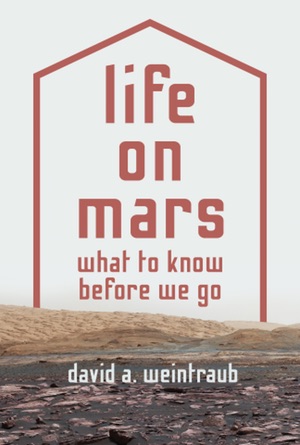Review: Life on Marsby Jeff Foust
|
| “For those who thought much about Mars, life on Mars was not a matter of ‘if,’” Weintraub writes of the early 20th century. |
But NASA and other agencies are still interested in the question of life on Mars: did it once exist, and might it still exist today? That has driven the bulk of NASA’s Mars exploration efforts for decades and has interested scientists long before the Space Age began. That search for life, including its many false positives along the way, is the subject of Life on Mars by Vanderbilt University astronomer David Weintraub.
Weintraub notes that there’s been a predisposition towards believing Mars was inhabited that goes back all the way to antiquity. “There is an infinite number of worlds, some like this world, others unlike it… nobody can prove that in one sort of world there might not be contained… the seeds out of which animals and plants arise,” wrote the Greek philosopher Epicurus more than 2,000 years ago, sounding a lot like a modern-day astrobiologist in a quote included in the book.
But even as this belief in “pluralism” of habitable worlds went out of fashion, scientists and the general public retained the belief that Mars was not just habitable but inhabited. “For those who thought much about Mars, life on Mars was not a matter of ‘if,’” Weintraub writes of the early 20th century. Instead, the question was what kind of life, including intelligent life, might exist there.
That belief affected studies of Mars throughout history, and up to the present day. There was a presumption that life existed on Mars, which colored observations of the planet and analyses of data, be it from telescopes on Earth or spacecraft at Mars. Over time, though, those findings would often be walked back as additional studies concluded those earlier discoveries were not, in fact, evidence of life there. In other words, scientists have effectively been working to disprove life exists on Mars, rather than prove it.
Weintraub includes several examples of this in the book, from the 19th century observations of “canals” on Mars to later efforts to study what many scientists thought there was “vegetation” on the planet. That carried over into the Space Age, from the Viking experiments to detect life and the biosignatures thought to exist in in Martian meteorite ALH84001 to studies of methane in the planet’s atmosphere that could be evidence of life. Throughout the book, he includes many examples of sensational discoveries that were often discredited after later studies failed to verify them.
He takes a dim, almost condescending view of much of that research, and coverage of it. He’s critical of the “science by press conference” often done with many discoveries, although that’s a problem not limited to the search for life in Mars. He also complains about uninformed reporters at some of these press conferences, such as one who apparently “slept through science classes in junior high school” when asking a question at a Viking press conference. Another chapter, on the search for Martian methane, reads at times like a college lecture on statistical significance.
But Weintraub has errors of his own in the book. He includes among a list of successful Mars missions Mars Observer, a spacecraft that suffered a mission-ending malfunction in 1993 before reaching Mars. And, discussing the Mariner 7 flyby of Mars in 1969, he writes, “Just two weeks after astronauts Neil Armstrong and Michael Collins put the first human footprints on the surface of the Moon, NASA was at the peak of its game.” Michael Collins? Professor, teach thyself.
| Searches for life, he argues, “provide good reasons for humanity to voluntarily delay our collective ambitions to colonize Mars and give the scientific community enough time to learn, to a high degree of certainty, whether Mars is and always has been sterile.” |
While the book offers a thorough, and skeptical, view of past Martian life discoveries, there’s a missing dimension. Weintraub appears to rely principally on what’s in the published literature about Mars. That’s understandable when dealing with historical studies, but less useful in the present day when scientists are alive and active and can provide insights beyond what’s been published in papers. For example, in a section about one study of Mars methane, he cites a series of conference abstracts by the research team. But, he doesn’t discuss what they actually presented at those conferences (if, in fact, they did present at all, since it’s not uncommon for abstracts to be withdrawn) and the reaction it got from fellow scientists.
That search for life is important, he argues at both the beginning and end of Life on Mars, because of plans for human missions to the planet either by space agencies or companies like SpaceX. Those missions will complicate the search for Martian life through the introduction of human life. “We the People want and expect scientists to find life on Mars,” he argues, adding that those efforts “provide good reasons for humanity to voluntarily delay our collective ambitions to colonize Mars and give the scientific community enough time to learn, to a high degree of certainty, whether Mars is and always has been sterile.” However, proving a negative—Mars is not home to indigenous life—is exceedingly difficult, and Weintraub doesn’t give any metrics for determining when that threshold is met. And, given the history recounted in the book, searching for life on Mars has long been filled with uncertainty.
